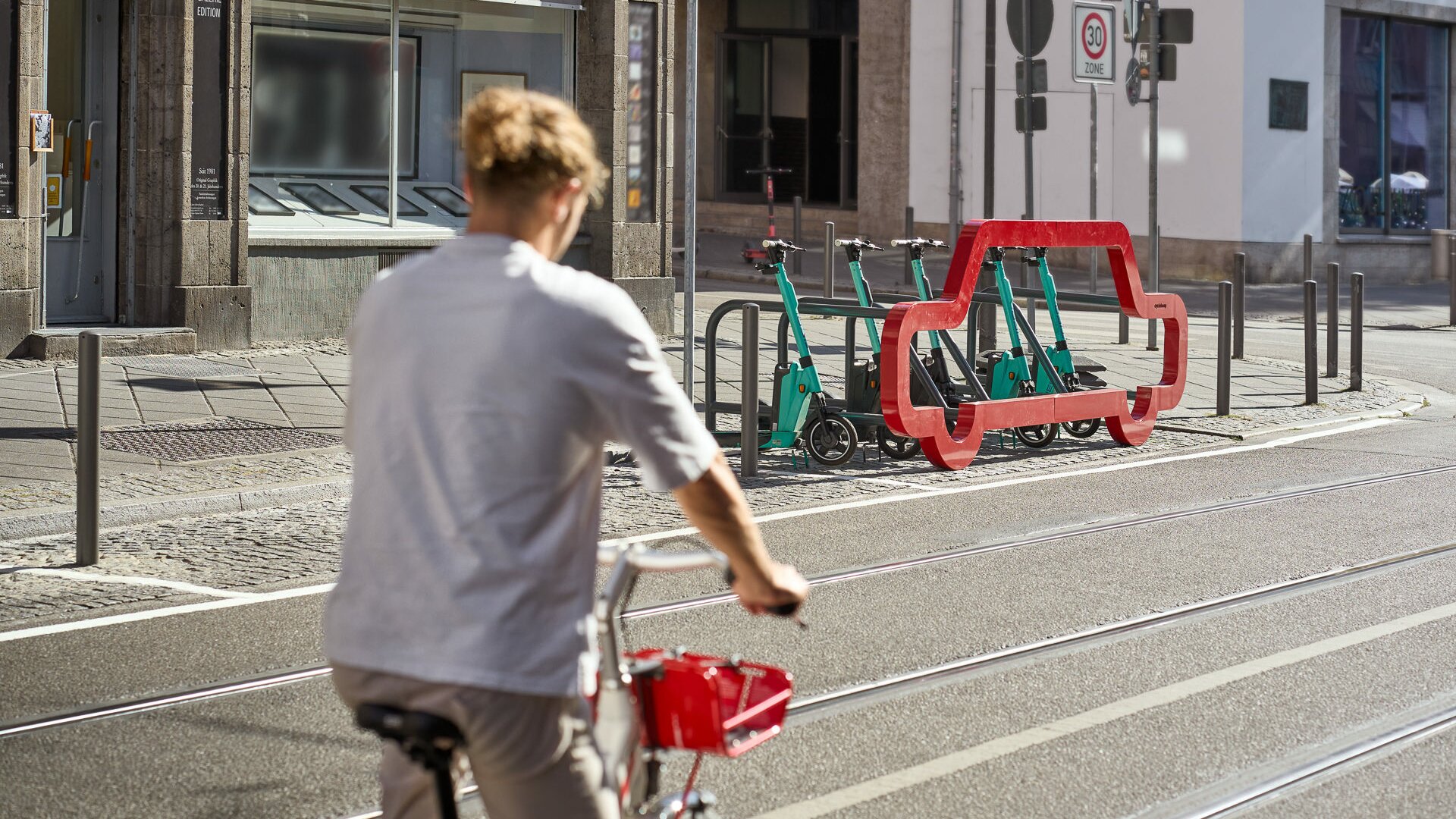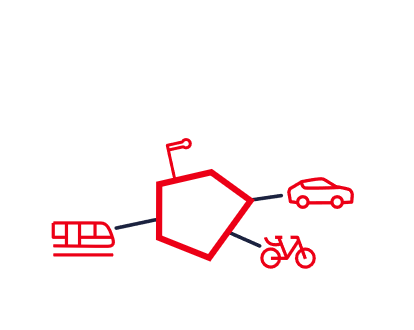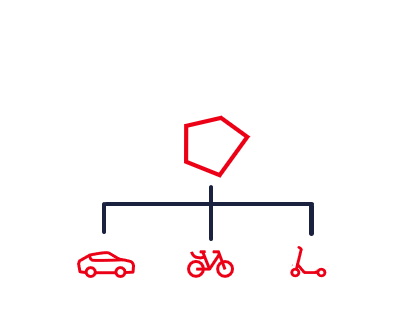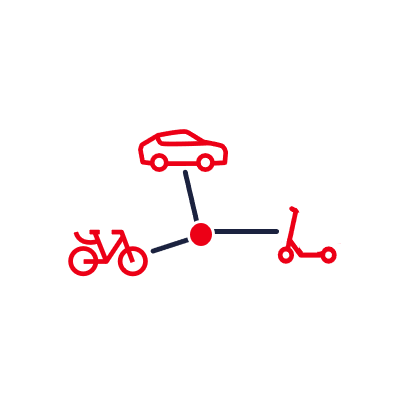
DB Curbside Management
Sharing services are available in a wide range and particularly widespread in urban areas. With our digital application, we offer cities and administrations the possibility to digitally observe, analyze and actively shape mobility within determined areas.
Managing mobility spaces: why?
Curbside management involves monitoring, managing, and optimizing public spaces in accordance with existing transportation offerings.
The goal is to organize a city's mobility in a way that a range of mobility services is accessible for every need. The management of public spaces thus paves the way for a successful mobility turnaround.
Who is curbside management relevant for?
First and foremost, anyone involved with planning public spaces is in contact with curbside management. In cities and municipalities, specific departments and public-sector entities are usually tasked with this, while station management is responsible in smaller scale at train stations, for example. We provide all of them with our digital software.
We consider it equally important to involve and exchange information with mobility providers in order to create a meaningful link between micromobility, public transportation, and the needs of citizens.
Digitally manage shared mobilty services and spaces:
With the Curbside Cockpit

We facilitate structuring public spaces: through our digital application called Curbside Cockpit. It provides public-sector departments and administrations with a map-based overview of the city and the locations of all stationary mobility services in real time.
The Curbside Cockpit is a multi-client, scalable software-as-a-service (SaaS) solution designed for municipalities, as well as all parties with a need for space management. Users can access the application easily and securely in the Internet browser without additional IT effort.
With our digital application, we provide insight into the mobility landscape of specified locations. Administrators of these spaces can analyze mobility data of stationary traffic, communicate digitally with mobility providers and share space regulations quickly and efficiently.
We pay attention to conformity with data protection, as well as the use of current standards to make all operations and communications between administrations and mobility providers as efficient as possible.
Curious?
Efficient urban mobility, designed digitally with our Curbside Cockpit: schedule a free live demo with us to learn more.
Get in contact
Geofencing for the City of Munich
The end of 2022 has marked the start of DB Curbside Management and the Munich Mobility Department collaborating, working on a digital geofencing concept.
Munich wants to use it to digitally plan and operate the further development of a multimodal transport system and increase traffic safety by setting up and monitoring digital parking spaces and no-parking zones.
Mobility hubs in action
Mobility concentrated in one place: At several train stations in Germany, local public transport is linked with shared mobility services, enabling seamless transfers for onward travel.
For managing these mobility hubs, our Curbside Cockpit application is working in the background: it contributes to the digital regulation of the designated parking areas and monitors the correct placement of all parked vehicles via GPS — while creating useful statistics for reporting purposes.
Use cases of our Curbside Cockpit
Whether in your city or at your mobility station: successful curbside management can be conducted in many ways via the cockpit tool. Many of your requirements are covered by our software:
Get data-based insights into your local mobility:
Leave a message via contact formTogether for safe and sustainable
micro mobility
Next to organizing shared mobility offers and managing public spaces, we can also help to improve safety within cities with our Curbside Cockpit.
Our whitepaper provides an outline on how to sustainably integrate micro mobility within the cityscape:
The term Curbside Management covers all activities connected with studying, optimising and managing the spaces that stationary vehicles occupy in urban settings. Curbside Management focuses on ensuring that mobility in a town or city works, i.e. that people have the best possible access to a combination of mobility services that cater to all kinds of needs. These services can take many different forms – sharing platforms for bikes and e-scooters, logistics companies, mass transportation and taxi operators.
Parking management focuses solely on the relationship between cars and urban space. Curbside Management takes a broader view of things: It encompasses all forms of mobility when assessing the impact of stationary vehicles.
It approaches the issue holistically: All needs relating to curbside usage are considered, and the resulting findings are then factored in when analysing, planning and managing transportation to reduce traffic congestion. Dedicated delivery spaces, dynamic parking regulations for electric scooters and virtual stops for shuttle services are just some of the measures that can promote the use of alternatives to cars and, at the same time, reduce the difficulties encountered by motorists, such as delivery vehicles blocking a road by double-parking.
Smart city and green city programmes redefine how urban spaces are used. Curbside Management and the related process of creating a digital image (or digital twin) of towns and cities are the ideal tools for achieving this goal. Innovative technologies, above all autonomous vehicles, require that urban spaces be clearly demarcated so the technology can function correctly, thus placing further demands on this setting.
Als Mobilitätsanbieter sehen wir die Straßenkante als längsten Bahnsteig einer Stadt an. Das ist der Ort an dem Mobilität beginnt, endet oder wechselt – und das über eine Vielzahl an Mobilitätsangeboten. Unter DB New Mobility ist es neben der Stärkung der Schiene das Ziel, integrierte Konzepte voranzutreiben, die klassische und neue Mobilitätsformen miteinander verbinden.
As a mobility service provider, we see the roadside as the longest platform in town. It is the place where mobility begins, finishes or changes mode – amid a wide variety of transportation methods. At DB New Mobility, our goal is twofold: strengthen rail transport and promote integrated transportation concepts that combine classic transportation types with new kinds of mobility.









